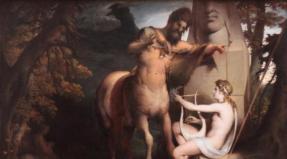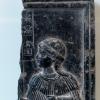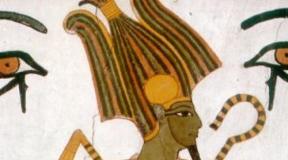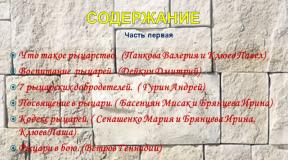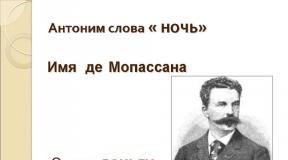Ancient gods of Egypt - Osiris. Osiris - god of ancient Egyptian mythology What Osiris looks like
15.01.2017
One of the most important figures in the ancient Egyptian pantheon of gods was Osiris. In Egyptian mythology, it is associated with fertility and agriculture, dying and being resurrected annually, like the plant world. In addition, reigning in the afterlife, he administered judgment over the dead.
Origin of Osiris
The priests of one of the ancient Egyptian religious centers of Heliopolis, at the basis of the origin of the universe and man, represented the nine most important gods - the Aenead. According to the Pyramid Texts, inscriptions found on the walls inside the fifth dynasty pyramids, Osiris was the eldest son of the sky goddess Nut and the earth god Geb, representing the fourth generation of gods. On the day of his appearance, it was already known that he would become the most powerful ruler on earth and in heaven, and that he was the son of the sun god Ra. The birthplace of Osiris is considered to be the desert located west of Memphis, the place where, according to the ancient Egyptians, the afterlife began.
The Egyptians depicted Osiris as a man with green skin, whose legs and lower torso were wrapped like a mummy, and in his hands were symbols of royal power: a flail and a hook. A distinctive feature of the deity was a high crown with feathers on the sides. Often the god was depicted surrounded by climbing plants, or the plant trunks themselves entwined the body of Osiris.
In addition to Osiris, the goddess Nut gave birth to the god Horus, the evil god of the desert Set, the goddess of love, motherhood and marital fidelity Isis and the patron goddess of the dead Nephthys. Isis and Osiris fell in love with each other in their mother's womb, and subsequently became husband and wife. These two figures are central to ancient Egyptian mythology.
The Life, Death and Rebirth of Osiris
Having inherited the throne from his father Geb, Osiris ruled the earth together with Isis. At that time, peace and tranquility reigned in Egypt. Osiris taught people agriculture, irrigation, crafts, the art of healing, writing and city building. People's observance of laws and veneration of gods became very important. After establishing order in Egypt, Osiris decided to go to other countries to teach other peoples. Isis remained to rule the country, who continued to teach the Egyptians medicine and magic, and women - housekeeping and family preservation.
Seth envied his brother and hated him for the love of people for their ruler. In addition, Seth was secretly in love with Isis. Having decided to kill Osiris, Seth ordered a sarcophagus to be made according to the measurements of his body, and upon his brother’s return from the trip, he called a feast. In the midst of dinner, servants brought in a sarcophagus decorated with precious metals and stones. Seth suggested that the guests take turns to lie down in the chest, and whoever gets it at the right time will receive an expensive gift. When Osiris lay down in the sarcophagus, the demons who helped Seth in the conspiracy slammed the lid, tied the sarcophagus with belts, sealed it with lead and threw it into the river.
The sarcophagus did not sink; it was carried by the current to the shores of Byblos, where it got stuck in the branches of the heather. When the tree grew, the sarcophagus ended up inside the trunk. The king of Byblos, seeing a strong tree, ordered it to be cut down and made into a column for the palace.
Having learned about what happened to her husband, Isis went in search of his body. The children she met along the way told her where they saw the sarcophagus. Having settled into the service of the ruler of Byblos, Isis persuaded the ruler to give her the column. Having cut the tree trunk, Isis removed her husband’s body from it. Isis sprinkled the trunk itself with oil and wrapped it in flax. Since then, the Djed tree pillar has been a symbol of Osiris.
Isis secretly took her husband's body to Egypt, where she hid it in the reeds on the banks of the Nile. One day, while going hunting, Seth came across the body of Osiris. In anger, he cut his brother into fourteen pieces and scattered them in different directions throughout Egypt.
Isis went again to look for her husband. Nephthys and the jackal-like god Anubis helped her in this. When any part of the body of Osiris was located, Isis performed a funeral rite in this place and erected a funerary stele. This explains the presence of several burials claiming to be the tombs of Osiris. The only part of the body that was not found was the phallus of Osiris, which was eaten by fish. Isis molded a phallus from clay and attached it to the reunited body of Osiris. Anubis helped swaddle and embalm the body. This is how the first mummy appeared in Egypt.
Isis greatly regretted that she had not given birth to a son, Osiris. Then, turning into a female kite, she spread her wings over her husband's mummy, using magic, extracted the life force from him and became pregnant. Isis named her born son Horus. When Horus grew up, he was able to take revenge on Set for the death of his father. Horus allowed his eye, torn out by Set at the very beginning of the battle, to be swallowed by his father, after which Osiris was resurrected. But Osiris did not return to earth, but became the ruler of the underworld. Horus remained to rule the earth, who later handed over the throne to the pharaohs.

Agricultural cult of Osiris
The description of the death and rebirth of Osiris in the myths is associated with his functions as the god of fertility and agriculture. Sowing was associated with the funeral of grain - Osiris, shoots - with his revival, harvest - with killing.
At the end of winter - beginning of spring, a ritual was held in Egypt, during which episodes of the myths about Osiris were recreated. The priestesses, personifying Isis and Nephthys, depicted the search for and mourning the death of a god. After this, the battle between Horus and Set was staged, ending with the erection of the “djed” pillar, dedicated to Osiris and signifying his rebirth (and the resurrection of nature).
The coronation rites of the pharaoh were also associated with Osiris. The young king was portrayed as Horus, and the deceased pharaoh became Osiris himself, suggesting that he would also come to life after death. Another ritual, which has become known to historians, personifies Osiris as the god of vegetation.
During the ritual, the statue of Osiris, located in the temple, was covered with grain and by the time of the holiday, plant shoots appeared, symbolizing the rebirth of the deity. Many drawings have been found depicting a priest watering the mummy of Osiris with ears of corn sprouting from it. The functions of Osiris related to agriculture were performed by the pharaoh during the rituals. Before the waters in the Nile began to rise, the pharaoh threw a scroll into the river with a decree for the water to overflow, at the harvest festival he cut the first sheaf and made sacrifices in gratitude to the gods.
The main ancient Egyptian center of the cult of Osiris was Abydos, where an annual festival was held in honor of the deity. It is believed that the tomb of Osiris is located in Abydos. The cult of Osiris was also widespread in the city of Jedu. In addition, over time, Osiris began to be revered as one of the most important gods not only throughout Egypt, but also beyond its borders.
Osiris - ruler of the underworld
The ancient Egyptians believed that, like Osiris, they would be reborn after death. Getting into the afterlife of the Duat, the deceased had to overcome many obstacles and appear before the gates of the Chamber of Two Truths, in which Osiris administered judgment. According to the Book of the Dead, during the trial Osiris sat on the throne surrounded by 42 gods (according to the number of nomes or provinces), and the gods Anubis and Thoth weighed the heart of the deceased, which personified the soul, on scales. The counterweight was Truth - the feather of the goddess of justice Maat.

The sinners were eaten by the monster Amat with the body of a lion and the head of a crocodile. A cloudless life awaited the righteous in the fields of Ialu. Any Egyptian knew and learned spells that could help him on his journey through the Duat, and the words of the acquittal speech that would be said at the trial of Osiris.
Relatives of the deceased had to provide the necessary material goods for existence in the afterlife. Later, prayers and spells addressed to Osiris and other gods with a request to assist the deceased in providing him with everything necessary received greater dominance over sacrificial benefits.
Since judgment in the face of Osiris was inevitable for any Egyptian, the cult of this deity was the most dominant, and the god himself was perceived as the most important of all others. Most residents of ancient Egypt believed in the justice of the highest court of the ruler of the afterlife and in the fact that the most important thing in court is not wealth and position, but moral qualities and actions.
Conclusion
The image of the god Osiris absorbed all the diversity of the evolution of the religion of ancient Egypt, combining in itself the cult of the king, the resurrecting god and the judge of the underworld. At the same time, his name is associated with an explanation of the most significant reproductive phenomena of the plant world for the Egyptians, as well as the emergence of human knowledge and skills. The influence of this deity extended to ancient Greek mythology, and even finds echoes in Christianity.
The name Osiris (Usir) came to us from ancient times; we have known it for almost five thousand years, and perhaps longer. Osiris was one of the most revered gods of the ancient Egyptian pantheon, and the Hellenes treated him with respect, associating him with Dionysus. Alchemists in the Middle Ages used his name in their search for the philosopher's stone, and aristocratic adventurers of the 18th century, such as Saint Germain and Cagliostro, under his divine protection tried to achieve immortality. Why does he have such respect? If you look more closely, even in the extravagant company of ancient deities, Osiris looks very peculiar. The story of his life, death, resurrection and posthumous existence remains one of the most curious myths of antiquity. Unfortunately, in this very antiquity, the myth of Osiris was reproduced in a relatively complete form only by Plutarch already at the beginning of our era. in the treatise "On Isis and Osiris". In it, elements of ancient Egyptian myths were mixed with episodes from ancient Greek ones, the names of many Egyptian gods were replaced with the names of their corresponding Greek ones. Even the ancient name Usir, belonging to the main character, was transformed into the Greek Osiris. As we know, it was this that later took root. So what does Plutarch write?
The first part of his work says that when Helios found out about Rhea’s secret marriage to Cronus, he cursed her. The curse was that she would not give birth in any month or year. But Hermes, in love with Rhea, fell in love with her, and then, playing checkers with the moon, he played the seventieth part of each of her cycles, added them together and got five days, and then put them to three hundred and sixty. The Egyptians still call them "inserted" and "birthdays of the gods."
To figure out who is who, you need to take into account that by Helios, Plutarch means the sun god Ra, the main ancient Egyptian god. The Greek goddess of the sky, Nut, is hidden under the Greek Rhea, and Seba should be understood under the name of Cronos, the god of the earth. The prototype of Hermes in Egyptian mythology is a god named Thoth. In what follows we will call them all according to Egyptian canons.

But Greek myths, as we know, are more than just a myth. In this one, for example, a cosmological background is clearly visible: a well-known astronomical fact is described - a certain discrepancy between the lunar and solar years. Those five days that Thoth wins at checkers against the Moon constitute this “astronomical gap.” Such a departure from the laws emanating from the supreme deity Ra, such a flagrant violation of his will - from the point of view of the ancient Egyptians - could only be caused by an event of extreme importance and, undoubtedly, belonging to the realm of the sacred.
Plutarch further says that on the first day Osiris was born, and at the moment of his birth a certain voice said: the Lord of All That Is is born. On the second day Arueris was born, whom the Greeks call Apollo, and some call the elder Horus. On the third day, Typhon was born, but at the wrong time and incorrectly: he jumped out of his mother’s side, piercing it with a blow. Typhon is Set, the ancient Egyptian god of the desert. On the fourth day, Isis was born in the moisture, and on the fifth, Nephthys, who is called Aphrodite. The myth says that Osiris and Arueris came from Ra, Isis from Thoth, and Set and Nephthys from Seb.
The fact that at his birth Osiris is proclaimed the Lord of All That Is is very significant: his divine right to rule was ordained from above. It is not without reason that in his first incarnation he acts as the Supreme Ruler, a kind of King of Kings, because his father, according to myth, was Ra himself. His brother Seth, who will play a very important role in the further narrative, embodies a destructive element from his very birth, which, in general, is not surprising for the desert. Seth is born violently and unnaturally. This contrast between the blessed fate of Osiris and the wicked fate of Set from the very beginning sets up a certain metaphorical duality, which will only develop in the future.

Subsequently, Nephthys became the wife of Set, and Isis and Osiris, having fallen in love with each other, united in the darkness of the womb even before birth. Hence the inevitable conclusion: incest in ancient Egyptian mythology is a completely normal thing. Moreover, the marriage of brothers and sisters is clearly under divine protection. This “norm” subsequently led to the degeneration of the pharaohs - due to numerous incestuous marriages.
Having reigned, Osiris instantly turned the Egyptians away from their poor and bestial lifestyle, gave them the fruits of the earth and taught them to honor the gods. Then he wandered, subjugating the entire earth to himself and not needing weapons at all, for he won most people over to his side, charming them with persuasive words combined with singing and music.

And although the fate of the Lord of the World was destined for Osiris from birth, he acts not only as a powerful ruler, but also as an enlightening monarch. And this function of Osiris is worth highlighting as key. The civilization of Ancient Egypt, according to most historians, would not have happened without their success in agriculture, in particular in the cultivation of cereals. It is therefore not surprising that Osiris, the god who brought humanity out of a primitive state, was the god of grain for the Egyptians. (I immediately remember the Russian proverb “Bread is the head of everything”) Here is what the famous anthropologist James Frazer writes about this in his work “The Golden Bough”: “Osiris is the god of grain. Consideration of this myth and ritual associated with Osiris, I think, is enough for this , to prove that in one of his hypostases this god was the personification of bread, which, figuratively speaking, dies every year and is reborn again. The details of the myth of Osiris are in good agreement with this interpretation. It says that Osiris was the offspring of Heaven and Earth. Which One could also wish for a pedigree for a god who grows out of the earth and is fertilized by heavenly moisture? True, the Egyptian land itself owed its fertility not to showers, but to the floods of the Nile, but its inhabitants must have known - or at least guessed that the great river was fed by rains ", falling in the depths of the country. The legend about Osiris, who taught people agriculture, is most directly related to the god of bread." Plutarch in his treatise explicitly associates Osiris with the Greek god of fertility - Dionysus. In one place he even directly says: “And who knows better than you, Kleia, that Osiris and Dionysus are one? It should be so: after all, it is you who lead the inspired priestesses at Delphi, destined by your father and mother for the mysteries of Osiris.” .
However, despite ample evidence of the identity of these two gods, the nature of their cults differs greatly. It is enough just to recall the work of Euripides “The Bacchae” and compare the wild rituals of the fans of Dionysus with the educational activities of Osiris. In the first part of the myth of Osiris, the “solar”, rational side of his religion is revealed; he appears as a supreme being, endowed with divine power and, at the same time, all-good, who brought civilization to people. The symbolic aspect is very important here: Osiris embodies in general any productive force; as psychoanalysts would put it - libido as such. In Plutarch's interpretation, he represents the divine Logos - the creative Word. It is not without reason that the ancient Egyptian phallic cult also belongs to it as a cult of fertility, a cult of active, producing energy.

The second part of Plutarch's work talks about the death of Osiris. Seth, upon Osiris’s return from his wanderings, began to prepare a trap for him, drawing as many as seventy-two people into the conspiracy and having the Ethiopian queen Aso as an “accomplice.” He secretly measured the body of Osiris, built a sarcophagus, beautiful and wonderfully decorated, and brought it to the feast. While this spectacle aroused delight and surprise, Seth, as if as a joke, offered to present the sarcophagus as a gift to someone who would like it in size. After everyone tried it in turn and not a single guest liked it, Osiris climbed in there too. The conspirators immediately ran up, slammed the lid and, having nailed it from the outside, filled it with hot lead, dragged the coffin into the river and launched it into the sea near Tanis, through the mouth, which is why the Egyptians still call it hateful and vile. According to myth, this happened on the seventeenth day of the month Aphira, when the sun crosses the constellation Scorpio, in the twenty-eighth year of the reign of Osiris.
Egyptian sources claim that the walled Osiris did not die immediately, but only on the fourteenth day. This is another reference to natural cycles: the ancient Egyptians associated the death of Osiris with the monthly waning of the moon, because exactly fourteen days pass from the full moon to the new moon. During this period, the moon seems to die - like Osiris. True, in this regard the question immediately arises: how could Osiris even die? Aren't the gods immortal? After all, even in Pushkin’s “The Tale of Tsar Saltan”, during the journey of the royal family across the “ocean sea” in a tarred barrel, the child did not die, but managed to grow up, learn to walk and talk. And although he grew “by leaps and bounds,” a lot of time still passed. It is strange that the characters of the Russian fairy tale survived in such circumstances, but the ancient Egyptian god died. But here, obviously, there is a hidden meaning in the way in which Osiris was killed. The sea horizon had a mystical meaning in the minds of some peoples and played the role of a line dividing the world of the living and the world of the dead. Hence the custom of burying the dead, releasing them in a boat into the open sea. And the sarcophagus is an extremely important element here - despite the fact that the obvious absurdity of this method of killing the Lord of All That is striking. However, they could not do without the sarcophagus, since it played the role of the ship that transported Osiris to the world of the dead.
Plutarch goes on to tell how Isis learned that Osiris, who loved her, had mistakenly slept with her sister as herself, and saw proof of this in the lotus wreath that he left with Nephthys. She began to look for the child, for Nephthys, having given birth, immediately hid him out of fear of her husband Seth; the child was found with great difficulty and with the help of dogs that led Isis; she fed him, named him Anubis, and he became her protector and companion, began to guard the gods like dogs guard people.

The funniest thing, of course, in this passage is the phrase “Osiris, who loves her, by mistake...” Either Plutarch was trying to keep up appearances, or was deliberately shielding Osiris - how can you sleep by mistake? However, now it becomes clear why Seth might have disliked his brother. For a "mistake". It is interesting that Isis reacted to this betrayal with understanding. For her, grief over the death of her husband was clearly stronger than jealousy. And in general there is not a word about jealousy here. This is not surprising: the pharaohs of Ancient Egypt often had several wives, so cheating on their “beloved wife” was not considered shameful.

Later, Isis learned that the sea had driven the sarcophagus to the shore of Byblos, where the surf carried it into the heather. And the heather, which quickly grew into a huge and beautiful trunk, embraced and sheltered him within itself. King Malcander of Byblos was surprised at the size of the plant and, cutting down the trunk containing the invisible coffin, placed it as a support for the roof. This is also not just an episode: its symbolic meaning is a reference to another aspect of the cult of Osiris. In addition to the above “specializations,” Osiris was also considered the god of trees in Ancient Egypt. For Plutarch, this was further proof of the complete identity of Osiris and Dionysus. It must be said that various cults of tree worship existed at different times and among different peoples. One of the most famous cults is the beliefs of the Druids. In some tribes of Oceania, for example, there was (and perhaps still exists) a tradition of burying their dead in the hollows of trees growing in a special sacred place. It was believed that the spirit of the deceased settles in such a tree and continues to live as long as the tree itself is alive.

Isis, having learned from the divine spirit of the rumor about what had become of the heather trunk, appeared in Byblos, sat down by the source, humble and tearful, and did not speak to anyone. True, she greeted the maids of Queen Byblos, caressed them, braided their hair and sent an amazing aroma from herself onto their bodies. As soon as the queen saw her maids at the spring, an attraction arose in her to the stranger, whose hair and body exuded incense. She took Isis to the palace and made her son her wet nurse. Tradition says that Isis nursed the child, putting a finger in his mouth instead of a breast, and at night she burned out the mortal shell of his body with fire; she herself, turning into a swallow, with a plaintive cry, curled around the support of the roof with her husband's sarcophagus - and so on until the queen lay in wait for her and screamed at the sight of the child on fire, thereby depriving him of immortality. Then the exposed Isis begged for support; She easily split the heather, and then, wrapping it in linen and anointing it with myrrh, she handed it to the king and queen. And now the inhabitants of Byblos still venerate the tree placed in the sanctuary of Isis. And they say that she fell on the coffin and screamed so much that the king’s youngest son died immediately, and she allegedly took the eldest with her and, placing the coffin on the ship, sailed away.

Strange story, isn't it? It is difficult to interpret, and stylistically it stands out somewhat from the rest of the narrative. For example, Isis’s behavior as a nurse is completely incomprehensible. However, we will find the answer by studying Homer’s hymn to Demeter, where the story of the burning of the child’s mortal coil is repeated almost word for word. In general, one can find a lot in common between the Greek Demeter and Isis. Firstly, they were both goddesses of agriculture. After all, Osiris, having taught people to cultivate the soil, later entrusted the care of observing agricultural cycles to his sister and wife. Both of them mourn and are in search: Isis is looking for Osiris, Demeter is looking for her daughter Persephone, kidnapped by Hades. Demeter also, having hidden her true origin, becomes a wet nurse in someone else's royal family - the Eleusinian king Kelei. And in both cases, the mother-queen witnesses a frightening sight and thereby destroys her child, who has not completed the cleansing ritual. As for the sanctuary of Isis, we are talking here, apparently, about the temple of Baalat-Gebal, which was actually located in Byblos during Plutarch’s life. It must be said that this temple was already very ancient at that time: the estimated time of its construction is approximately 2800 BC. The tree mentioned by Plutarch was most likely indeed a sacred artifact of this temple. So mythology here closely merges with history.

As for the style, the second part of the legend is quite strikingly different from the first part; It also differs in its general atmosphere. The first deals with “vertical” processes, mainly cosmological ones: it tells how gods are born and descend from heaven, how people receive various abilities as a divine gift. In the second, events develop rather in a horizontal plane. The gods in their actions are more like people: they deceive, betray, die, suffer - and their divine nature is no longer so obvious. It is also curious that intrigue is introduced into the plot of the myth, which is not typical for archaic cults. Characters involved in dramatic reality exhibit interesting characteristics. Isis, for example, appears as a magician. If Seth achieves his goal with force and cunning, then Isis uses the hidden forces of nature, power over which she was given at birth, to achieve her goals.

The third, most interesting part, describes the resurrection of Osiris and his subsequent accession to the Kingdom of the Dead. According to Plutarch, Isis then went to But to her son Horus, who was raised there, and placed the coffin away from the road. Seth, hunting by moonlight, came across it and, recognizing the body, tore it into fourteen pieces and scattered them. Isis found out about this and went in search, crossing the swamps on a papyrus boat. Subsequently, the opinion was born that crocodiles allegedly do not touch those floating on papyrus boats, experiencing either fear or reverence for the goddess. And this is supposedly why there are so many tombs of Osiris in Egypt - after all, Isis, while searching for him, buried every part of him. Some, however, deny this and say that she made statues and granted them to each city instead of the body of Osiris so that Seth, if he defeated Horus and began to look for the true tomb, would simply get confused and find nothing. It is curious that of all the parts of Osiris’s body, Isis did not find only the phallus, for it immediately fell into the river and the lepidotes, fagr and sturgeons fed on it. Now the Egyptians abhor these fish. Isis, instead of the phallus, made an image of it and consecrated it; The Egyptians still hold festivals in his honor.

In this part, one of the most important elements is the dismemberment of the body of Osiris into fourteen parts. Firstly, this explains why there were sanctuaries scattered throughout Ancient Egypt, the priests of which claimed that it was in their sanctuary that the ashes of Osiris were buried. The main thing was located in Memphis, where, according to legend, the head was buried. Fraser gives an interesting symbolic interpretation of this fragment: Osiris is associated with grains that are buried in the earth for subsequent “resurrection” in new ears. So the division of Osiris into parts is the division into parts not of the body, but of the ear - for its subsequent revival. This version is supported by some elements of the cult of Osiris, in which grains of wheat actually represent his reproductive energy. A parallel can be drawn with Christianity, because the enormous symbolic meaning of bread in the Holy Scriptures is well known. Bread also plays an important role in church sacraments. So, in the divine liturgy, one of the key rites of both Orthodoxy and Catholicism, it symbolizes the body of Christ. It should be noted that this point was perceived very ambiguously at the dawn of Christianity by its opponents. For example, many considered (and still consider) Christians crazy for “eating the body of their own god.” It got to the point where Christians were accused of cannibalism. However, the ignorant Romans did not know that the bread in this sacrament was a symbol of the resurrection of Christ, and by eating the bread, Christians partook of eternal life.

It is a pity that Plutarch says little and in passing about the resurrection of Osiris. But in Egyptian sources it is of central importance. It must be said that the retelling of the Greek scientist is somewhat different from the Egyptian primary sources. The famous Egyptologist Walliss Budge in the book “Egyptian Magic” provides a translation of the original ancient Egyptian text dedicated to the god Thoth: “Having found the dead body of her husband, Isis soared over him like a bird, and the blows of her wings generated wind, and her shining plumage emitted light. With her “words of power” "She resurrected the dead body. From their embrace during this meeting, Horus was born. Isis raised and educated him in a secret refuge in the reed swamps." It turns out - according to these texts - that Horus was conceived after the resurrection of Osiris, and the resurrection itself was the result of the magical manipulations of Isis, who received support from the god of the sky - Thoth.

Another option is available in the aforementioned “Golden Bough” by Fraser. There, when the body of Osiris was found, Isis and Nephthys staged a funeral lament. The lamentations of the sisters were not in vain: Ra took pity on their grief and sent the god Anubis with the head of a jackal from heaven, and with the help of Isis, Nephthys, Thoth and Horus, he put together a dead body from pieces, swaddled it in linen and performed on it all the rituals that the Egyptians performed over the bodies of the dead. After this, Isis raised the cooled dust with the flap of her wings, Osiris came to life and began to rule in the kingdom of the dead, sitting in the great hall of the Two Truths in the company of forty-two advisers and passing judgment on the souls of the dead. They solemnly confessed to him, and, after their hearts were weighed on the scales of justice, received eternal life as a reward for virtue or due punishment for sins.

This option contains a reference to the ritual of mummification - one of the most unique features of ancient Egyptian culture: every ancient Egyptian dead person buried according to the ritual was associated with Osiris. The reign of Osiris in the Underworld, his title of Lord of the Dead, Master of Eternity, is a continuation of his past, when he was the Lord of All That Is. Having been resurrected, Osiris becomes a symbol of immortality, the guarantee of eternal life.
Plutarch outlined the denouement of the legend, one might say, “close to the text”: in it, Osiris is assigned victory in the battle between good and evil.

Further, Osiris, appearing to Horus from the kingdom of the dead, trained him for battle, and then asked him what he considered the most beautiful thing in the world. Horus answered: to avenge the father and mother who were harmed. Subsequently, many went over to Horus’s side, and Seth’s concubine Tueris also appeared to him. She was pursued by a snake, but Horus' friends killed the snake. In memory of this event, they still throw a rope and cut it in the middle.

Horus won the battle, which lasted many days. Isis received the chained Seth, but did not execute him, but untied him and released him. Horus got angry and tore the royal crown from her head, but He crowned her with a horned helmet. Set then brought the charge of illegitimacy against Horus, but under the protection of Thoth, Horus was recognized by the gods as the legitimate son, and Set was defeated in two more battles.
The fight with Seth has a metaphysical character in the legend. The confrontation between the creator Osiris and the destroyer Set is reminiscent of the cosmic war between Ahura Mazda and Angra Mainyu in ancient Persian mythology. Zoroastrianism, which arose in Azerbaijan and Persia, gave rise to Manichaeism, which also considers the struggle between good and evil principles, equal in power, as the central theme of the world drama. It is difficult to say whether this is the result of cultural borrowing or the embodiment of one archetype on different cultural grounds. In any case, many of the features that were later successfully developed in Christianity were also present in these ancient cults. In general, many researchers emphasized the external similarity of the cult of Osiris and Christianity. The most striking parallel runs between the images of Christ and Osiris: both are the sons of the supreme god, both are God’s anointed for the great kingdom, both embodied both the nature of God and the nature of man, both brought people a divine gift embodied in the word, both died innocently and both resurrected, showing people the way to eternal life. There are parallels between their earthly lives, for example, Jesus distributing bread during the Sermon on the Mount and Osiris teaching people how to tillage. It does not directly follow from this that the image of Christ was borrowed from the ancient Egyptian religion, but it is known that not a single religion was born out of nowhere - it absorbed the features of the previous one. In any case, in ancient times Osiris inspired his followers no less than Christ inspired Christians. For many centuries, the Egyptians believed in eternal life, the guarantor of which was Osiris. During the Hellenic period, there was even a living emanation of Osiris - the sacred bull Apis. According to legend, the soul of Osiris moved into this animal, which has a number of special characteristics.

Today, the belief in Osiris, like the entire ancient Egyptian civilization, is buried under a layer of sand. However, the legend of this ancient god still lives on. And who knows, maybe one day the seeds of his divine Word will sprout, presenting to the world a new incarnation of Osiris.
The mythology of Ancient Egypt is interesting and is largely connected with numerous gods. For every important event or natural phenomenon, people came up with their own patron, and they differed in external signs and characteristics.
The main gods of Ancient Egypt
The country's religion is distinguished by the presence of numerous beliefs, which is directly reflected in the appearance of the gods, who in most cases are presented as a hybrid of humans and animals. Egyptian gods and their meaning were of great importance to people, as evidenced by numerous temples, statues and images. Among them are the main deities who were responsible for important aspects of the life of the Egyptians.
Egyptian god Amon Ra
In ancient times, this deity was depicted as a man with the head of a ram or completely in the form of an animal. In his hands he holds a cross with a loop, which symbolizes life and immortality. It combines the gods of Ancient Egypt Amun and Ra, so it has the power and influence of both. He was favorable to people, helping them in difficult situations, and therefore was presented as a caring and fair creator of all things.
And Amon illuminated the earth, moving across the sky along the river, and at night transferring to the underground Nile to return to their home. People believed that every day at midnight he fights with a huge snake. Amon Ra was considered the main patron of the pharaohs. In mythology, one can notice that the cult of this god constantly changed its significance, sometimes falling, sometimes rising.

Egyptian god Osiris
In Ancient Egypt, the deity was represented in the form of a man wrapped in a shroud, which added to the resemblance to a mummy. Osiris was the ruler of the underworld, so his head was always crowned. According to the mythology of Ancient Egypt, this was the first king of this country, so in his hands are symbols of power - a whip and a scepter. His skin is black and this color symbolizes rebirth and new life. Osiris is always accompanied by a plant, such as a lotus, a vine and a tree.
The Egyptian god of fertility is multifaceted, meaning Osiris performed many duties. He was revered as the patron of vegetation and the productive forces of nature. Osiris was considered the main patron and protector of people, and also the ruler of the underworld, who judged dead people. Osiris taught people to cultivate the land, grow grapes, treat various diseases and perform other important work.

Egyptian god Anubis
The main feature of this deity is the body of a man with the head of a black dog or jackal. This animal was not chosen at all by chance, the whole point is that the Egyptians often saw it in cemeteries, which is why they were associated with the afterlife. In some images, Anubis is represented entirely in the form of a wolf or jackal, which lies on a chest. In ancient Egypt, the jackal-headed god of the dead had several important responsibilities.
- Protected graves, so people often carved prayers to Anubis on tombs.
- He took part in the embalming of gods and pharaohs. Many depictions of mummification processes featured a priest wearing a dog mask.
- A guide for dead souls to the afterlife. In Ancient Egypt, they believed that Anubis escorted people to the judgment of Osiris.
He weighed the heart of a deceased person to determine whether the soul was worthy of going to the afterlife. A heart is placed on the scales on one side, and the goddess Maat in the form of an ostrich feather is placed on the other.

Egyptian god Set
They represented a deity with the body of a man and the head of a mythical animal, which combines a dog and a tapir. Another distinctive feature is the heavy wig. Set is the brother of Osiris and, in the understanding of the ancient Egyptians, is the god of evil. He was often depicted with the head of a sacred animal - a donkey. Seth was considered the personification of war, drought and death. All troubles and misfortunes were attributed to this god of Ancient Egypt. They did not renounce him only because they were considered the main defender of Ra during the night battle with the serpent.

Egyptian god Horus
This deity has several incarnations, but the most famous is a man with the head of a falcon, on which there is certainly a crown. Its symbol is the sun with outstretched wings. The Egyptian sun god lost his eye during a fight, which became an important sign in mythology. It is a symbol of wisdom, clairvoyance and eternal life. In ancient Egypt, the Eye of Horus was worn as an amulet.
According to ancient ideas, Horus was revered as a predatory deity who latched onto his prey with falcon talons. There is another myth where he moves across the sky on a boat. The sun god Horus helped Osiris to resurrect, for which he received the throne in gratitude and became the ruler. Many gods patronized him, teaching him magic and various wisdom.

Egyptian god Geb
Several original images found by archaeologists have survived to this day. Geb is the patron of the earth, which the Egyptians sought to convey in an external image: the body is elongated, like a plain, arms raised upward - the personification of the slopes. In Ancient Egypt, he was represented with his wife Nut, the patroness of heaven. Although there are many drawings, there is not much information about Geb's powers and purposes. The god of the earth in Egypt was the father of Osiris and Isis. There was a whole cult, which included people working in the fields to protect themselves from hunger and ensure a good harvest.

Egyptian god Thoth
The deity was represented in two guises and in ancient times, it was an ibis bird with a long curved beak. He was considered a symbol of dawn and a harbinger of abundance. In the later period, Thoth was represented as a baboon. There are gods of Ancient Egypt who live among people, and one of them is He, who was the patron of wisdom and helped everyone learn science. It was believed that he taught the Egyptians writing, counting, and also created a calendar.
Thoth is the god of the Moon and through its phases he has been associated with various astronomical and astrological observations. This was the reason for his transformation into a deity of wisdom and magic. Thoth was considered the founder of numerous religious rites. In some sources he is ranked among the deities of time. In the pantheon of gods of Ancient Egypt, Thoth occupied the place of scribe, vizier of Ra and secretary of judicial affairs.

Egyptian god Aten
The deity of the solar disk, who was represented with rays in the form of palms, reaching towards the earth and people. This distinguished him from other humanoid gods. The most famous image is presented on the back of Tutankhamun's throne. There is an opinion that the cult of this deity influenced the formation and development of Jewish monotheism. This sun god in Egypt combines masculine and feminine traits at the same time. In ancient times they also used the term “silver of Aten”, which meant the Moon.

Egyptian god Ptah
The deity was represented in the form of a man who, unlike others, did not wear a crown, and his head was covered with a headdress that looked like a helmet. Like other gods of Ancient Egypt associated with the earth (Osiris and Sokar), Ptah was clothed in a shroud that exposed only the hands and head. External similarity led to a merger into one common deity Ptah-Sokar-Osiris. The Egyptians considered him a beautiful god, but many archaeological finds refute this opinion, since portraits were found where he is represented as a dwarf trampling animals underfoot.
Ptah is the patron saint of the city of Memphis, where there was a myth that he created everything on earth with the power of thought and word, so he was considered a creator. He had a connection with the earth, the burial place of the dead and sources of fertility. Another purpose of Ptah is the Egyptian god of art, which is why he was considered a blacksmith and sculptor of humanity, and also the patron of artisans.

Egyptian god Apis
The Egyptians had many sacred animals, but the most revered was the bull - Apis. He had a real embodiment and was credited with 29 signs that were known only to the priests. They were used to determine the birth of a new god in the form of a black bull, and this was a famous holiday in Ancient Egypt. The bull was placed in the temple and was surrounded with divine honors throughout his life. Once a year, before the start of agricultural work, Apis was harnessed and the pharaoh plowed a furrow. This ensured a good harvest in the future. After death, the bull was solemnly buried.
Apis, the Egyptian god who protects fertility, was depicted with a snow-white skin with several black spots, and their number was strictly determined. It is presented with different necklaces that corresponded to different holiday rituals. Between the horns is the solar disk of the god Ra. Apis could also take human form with the head of a bull, but this idea was widespread in the Late Period.

Pantheon of Egyptian Gods
Since the birth of ancient civilization, belief in a Higher Power arose. The Pantheon was populated by gods who had different abilities. They did not always treat people favorably, so the Egyptians built temples in their honor, brought gifts and prayed. The pantheon of Egyptian gods has more than two thousand names, but less than a hundred of them can be classified as the main group. Some deities were worshiped only in certain regions or tribes. Another important point is that the hierarchy could change depending on the dominant political force.



Osiris (in Ancient Egypt this name was most likely pronounced as Usir) is an Egyptian god most often revered as the ruler of the underworld of the dead, but more closely associated with the ideas of transition from one thing to another, resurrection and revival. He was depicted as a man with green skin and a pharaoh's beard, with mummy shrouds on his legs. Osiris wore a special crown with two large ostrich feathers on each side, and in his hands he held a symbolic staff and flail. At one time, Osiris was considered the eldest son of the earth god Geb, although other sources claimed that his father was the sun god Ra, and his mother was the sky goddess Chickpeas. Osiris was the brother and husband of the goddess Isis, who after his death gave birth to his son Horus. He bore the epithet Khenti-Amenti, meaning "First of the Westerners" - an allusion to his dominion in the land of the dead. As ruler of the dead, Osiris was sometimes called the "king of the living," for the ancient Egyptians believed that the blessed dead were the "truly living." Osiris was considered the brother of the gods Isis, Set, Nephthys. The first information about Osiris dates back to the middle of the Fifth Dynasty of Ancient Egypt, although it is likely that he was worshiped much earlier: the epithet Khenti-Amenti dates back to at least the First Dynasty, as does the title " Pharaoh" Most of the myths about Osiris are based on allusions contained in the Pyramid Texts of the late 5th Dynasty, on much later documentary sources from the New Kingdom, such as the Shabaka Stone and the “Struggle of Horus and Set”, and on later writings of Greek authors, including Plutarch and Diodorus Sicilian.
Osiris was considered not only the merciful judge of the dead in the afterlife, but also the underground force that gave birth to all life, including vegetation and the fertile floods of the Nile. He was called the “Lord of Love,” “Eternally Good and Young,” and “Lord of Silence.” The rulers of Egypt were connected with Osiris after death, resurrecting, like him, from the dead to eternal life through magic. By the time of the New Kingdom, not only the pharaohs, but all people, could establish a connection with Osiris after death if they paid for the appropriate rituals.
Through the image of posthumous rebirth, Osiris became associated with natural cycles, in particular with the annual renewal of vegetation and the floods of the Nile, with the rise of Orion and Sirius at the beginning of the new year. Osiris was massively worshiped as the Lord of the Dead until the suppression of the old Egyptian religion after the triumph of Christianity.
Origin of the name "Osiris"
Osiris is the Greek and Latin pronunciation of the word, rendered in Egyptian hieroglyphs as "Wsjr". Since the hieroglyphic script does not indicate all the vowels, Egyptologists transliterate the true sound of this name in different ways: Asar, Yashar, Aser, Asaru, Ausar, Ausir, Usir, etc.
There are several hypotheses to explain the origin of this Egyptian word. John Gwyn Griffiths (1980) suggests that it comes from the root Wser meaning "powerful". One of the oldest known attestations of Osiris on the mastaba of a deceased person is Netjer-Wser (God Almighty).
David Lorton (1985) believes that Wsjr consists of the morpheme set-jret meaning "worship". Osiris is “the one who receives worship.” Wolfhart Westendorf (1987) suggests an etymology from Waset-jret - "Parent of the eye".
In its most developed form of iconography, Osiris is depicted wearing the Atef crown, similar to the white crown of the rulers of Upper Egypt, but with the addition of two curly ostrich feathers on each side. In his hands he has a staff and a flail. The staff is believed to represent Osiris as the god of shepherds. The symbolism of the flail is less defined: sometimes it is compared to a shepherd’s whip.
Osiris is usually depicted as a pharaoh with a green (the color of rebirth) or black (an allusion to the fertile silt of the Nile) face. His body below the chest is wrapped in shrouds mummies. Less commonly, Osiris is depicted as a lunar god with a crown encircling the moon. In the horoscopes of lucky and unlucky days, the connection of Osiris with the moon is mentioned.

Osiris. Image from the tomb of Senjem, 19th Dynasty
Myths about Osiris
The idea of posthumous divine justice for sins committed in life is first encountered in the era of the Old Kingdom, in the inscriptions of one tomb of the 6th dynasty, containing fragments of a kind of “negative confession”: the sinner lists not his sins, but the offenses of which he Not committed.

Weighing the heart of the scribe Hunefer at the afterlife court of the god Osiris. "Book of the Dead"
With the growing influence of the cult of Osiris during the Middle Kingdom, the “democratized religion” began to promise even its poorest adherents the prospect of eternal life. Moral purity, not nobility, became the main measure of personality.
The Egyptians believed that after death a person appears before forty-two divine judges. If he led a life according to the instructions of the goddess of truth Maat, he was accepted into the Kingdom of Osiris. If he was found guilty, then he was thrown to the “Eater” monster, and he did not participate in eternal life.
A person given to the Devourer was first subjected to terrible punishment and then destroyed. Egyptian depictions of posthumous punishment, through early Christian and Coptic texts, may have influenced medieval ideas about hell.
Those who were found justified were purified on the "Flame Island", triumphing over evil and being reborn. The damned faced complete destruction and oblivion. Ideas about eternal torment The ancient Egyptians did not.
Acquittal at the posthumous trial of Osiris was the main concern of the ancient Egyptians.
Osiris and Serapis
When the Greek Lagid dynasty reigned in Egypt, its rulers decided to create an artificial deity that could be worshiped by both the indigenous inhabitants of the country and the Hellenic settlers. The goal was to bring both of these groups closer to each other. Osiris was visibly identified with the sacred bull Apis. On this basis a syncretic cult was created Serapis, in which Egyptian spiritual motifs were combined with a Greek appearance.
Fall of the Cult of Osiris
The worship of Osiris continued until the 6th century AD on the island of Philae (Upper Nile). The decrees of Emperor Theodosius I issued in the 390s on the destruction of all pagan temples were not applied there. The worship of Isis and Osiris was allowed on Philae until the time of Justinian I, according to a treaty between Emperor Diocletian and the Blemmyean and Nubian tribes. Every year these natives visited Elephantine and from time to time carried the image of Isis up the river to the country of the Blemmyes for prophecy. All this was put to an end when Justinian sent the famous general Narses destroy the sanctuaries, capture the priests and capture the divine images that were delivered to Constantinople.
Let's begin.
Osiris, in Egyptian mythology, the god of the productive forces of nature, the ruler of the underworld, the judge in the kingdom of the dead. Osiris was the eldest son of the earth god Geb and the sky goddess Nut, brother and husband of Isis. He taught the Egyptians agriculture, viticulture and winemaking, mining and processing of copper and gold ore, the art of medicine, the construction of cities, and established the cult of the gods.
Osiris was usually depicted as a man with green skin, sitting among trees, or with a vine entwining his figure. It was believed that, like the entire plant world, Osiris dies annually and is reborn to new life, but the fertilizing life force in him remains even in the dead. Myth:
Set, his brother, the evil god of the desert, decided to destroy Osiris and made a sarcophagus according to the measurements of his older brother. Having arranged a feast, he invited Osiris and announced that the sarcophagus would be presented to the one who fit the bill. When Osiris lay down in the sarcophagus, the conspirators slammed the lid, filled it with lead and threw it into the waters of the Nile. (Picking up a sarcophagus during life was normal at that time.)
The faithful wife of Osiris, Isis, found her husband’s body, miraculously extracted the life force hidden in him and conceived a son named Horus from the dead Osiris. When Horus grew up, he took revenge on Set. Horus gave his magic Eye, torn out by Seth at the beginning of the battle, to his dead father to swallow. Osiris came to life, but did not want to return to earth, and, leaving the throne to Horus, began to reign and administer justice in the afterlife.  Seth, in Egyptian mythology, the god of the desert, that is, “foreign countries,” the personification of the evil principle, the brother and killer of Osiris. During the era of the Old Kingdom, Set was revered as a warrior god, assistant to Ra and patron of the pharaohs.
Seth, in Egyptian mythology, the god of the desert, that is, “foreign countries,” the personification of the evil principle, the brother and killer of Osiris. During the era of the Old Kingdom, Set was revered as a warrior god, assistant to Ra and patron of the pharaohs.
As the personification of war, drought, death, Seth also embodied the evil principle - as the deity of the merciless desert, the god of foreigners: he cut down sacred trees, ate the sacred cat of the goddess Bast, etc.
The sacred animals of Seth were considered to be the pig (“disgust for the gods”), antelope, giraffe, and the main one was the donkey. The Egyptians imagined him as a man with a thin, long body and a donkey's head. Some myths attributed to Seth the salvation of Ra from the serpent Apophis - Seth pierced the giant Apophis, personifying darkness and evil, with a harpoon.  Myth:
Myth:
Set, jealous of his brother Osiris, killed him, threw his body into the Nile and legally took his throne. But the son of Osiris, Horus, who had been hiding for many years, wanted to take revenge on Set and take his throne. Horus and Set fought for eighty years. During one of the battles, Seth tore out Horus's eye, which then became the great amulet of the Udjat; Horus castrated Seth, depriving him of most of his essence.  Horus or Horus, Horus (“height”, “sky”), in Egyptian mythology the god of the sky and the sun in the guise of a falcon, a man with the head of a falcon or a winged sun, the son of the fertility goddess Isis and Osiris, the god of productive forces. Its symbol is a solar disk with outstretched wings. Initially, the falcon god was revered as a predatory god of the hunt, with his claws digging into his prey.
Horus or Horus, Horus (“height”, “sky”), in Egyptian mythology the god of the sky and the sun in the guise of a falcon, a man with the head of a falcon or a winged sun, the son of the fertility goddess Isis and Osiris, the god of productive forces. Its symbol is a solar disk with outstretched wings. Initially, the falcon god was revered as a predatory god of the hunt, with his claws digging into his prey.  Myth:
Myth:
Isis conceived Horus from the dead Osiris, who was treacherously killed by the formidable desert god Set, his brother. Retiring deep into the swampy Nile Delta, Isis gave birth to and raised a son, who, having matured, in a dispute with Set, sought recognition of himself as the sole heir of Osiris.
In the battle with Set, the killer of his father, Horus is first defeated - Set tore out his eye, the wonderful Eye, but then Horus defeated Set and deprived him of his masculinity. As a sign of submission, he placed the sandal of Osiris on Seth's head. Horus allowed his wonderful Eye to be swallowed by his father, and he came to life. The resurrected Osiris handed over his throne in Egypt to Horus, and he himself became the king of the underworld.  Isis or Isis, in Egyptian mythology, the goddess of fertility, water and wind, a symbol of femininity and marital fidelity, the goddess of navigation. Isis helped Osiris to civilize Egypt and taught women to reap, spin and weave, cure diseases and established the institution of marriage. When Osiris went to wander the world, Isis replaced him and wisely ruled the country.
Isis or Isis, in Egyptian mythology, the goddess of fertility, water and wind, a symbol of femininity and marital fidelity, the goddess of navigation. Isis helped Osiris to civilize Egypt and taught women to reap, spin and weave, cure diseases and established the institution of marriage. When Osiris went to wander the world, Isis replaced him and wisely ruled the country.  Myth:
Myth:
Hearing about the death of Osiris at the hands of the god of evil Set, Isis was dismayed. She cut her hair, put on mourning clothes and began searching for his body. The children told Isis that they had seen a box containing the body of Osiris floating down the Nile. The water carried him under a tree that grew on the shore near Byblos, which began to grow rapidly and soon the coffin was completely hidden in its trunk.
Upon learning of this, the king of Byblos ordered the tree to be cut down and brought to the palace, where it was used as a support for the roof in the form of a column. Isis, having guessed everything, rushed to Byblos. She dressed poorly and sat down by a well in the center of the city. When the queen's maids came to the well, Isis braided their hair and wrapped it in such a fragrance that the queen soon sent for her and took her son as a teacher. Every night Isis placed the royal child in the fire of immortality, and she herself, turning into a swallow, flew around the column with her husband’s body. Seeing her son in the flames, the queen uttered such a piercing cry that the child lost his immortality, and Isis revealed herself and asked to give her the column. Having received the body of her husband, Isis hid him in a swamp. However, Seth found the body and cut it into fourteen pieces, which he scattered throughout the country. With the help of the gods, Isis found all the pieces except the penis, which had been swallowed by the fish.
According to one version, Isis collected the body and revived Osiris to life using her healing powers, and conceived from him the god of the sky and sun, Horus. Isis was so popular in Egypt that over time she acquired the characteristics of other goddesses. She was revered as the patroness of women in labor, determining the fate of newborn kings. 
Read also...
- Marduk Vaal Marduk god of Abraham's homeland Babylon Akkad Sumer interfluve religion Supreme god and patron of Babylon
- The Mystery of the Immaculate Conception
- Emancipated women's societies: a view from time immemorial (on the leading role of women in the development of human civilizations and the existence of states and peoples governed by women)
- Osiris - god of ancient Egyptian mythology What Osiris looks like

